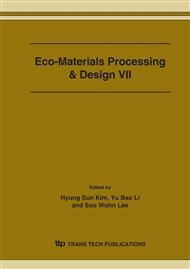p.898
p.902
p.906
p.910
p.914
p.918
p.922
p.926
p.930
Estimation of Environment-Friendly Permeable Pavement at Laboratory Test
Abstract:
The creation of large impervious surface in urban and urbanizing areas commonly leads to multiple impacts on the stream systems including higher peak runoff, reduced infiltration, and increased pollutant loads to streams. Permeable pavements made up of a matrix of concrete blocks with voids offer one solution to the problem of increased stormwater runoff and decreased stream water quality. Experiment results indicate that lower pore size pavement showed a higher runoff reduction rate compared with other pavement. Also, water absorption capability of pavement will drop the surface temperature of pavement. Compared to runoff, the turbidity and phosphorus concentration were lower than 27 [NTU] and 0.5 [mg/L], respectively. It appears that turbidity and hosphorus are concentrated in the pavement void.
Info:
Periodical:
Pages:
914-917
Citation:
Online since:
March 2006
Authors:
Price:
Сopyright:
© 2006 Trans Tech Publications Ltd. All Rights Reserved
Share:
Citation:


